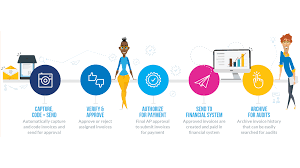What is Invoice Automation?
Businesses utilise automated invoice processing system software to assist optimise their accounts payable procedures by automatically paying supplier invoices. Invoice processing automation entails taking invoice data from a system and seamlessly integrating it into your ERP or accounts payable system, allowing you to make payments in minutes.
Automated invoice processing generally includes automation of:
Invoice administration can be handled effectively with the help of a clever automation system.
The accounts payable department is in charge of invoice processing. The typical process entails inputting invoice data in a timely manner, creating paper invoices, matching purchase orders, and filing indefinitely. It's a cumbersome procedure that contributes to an inefficient workplace. Invoices are received through mail, fax, email, and other methods.
This is why the application process must be automated. It's the next step in the manual processing procedure. Artificial intelligence and machine learning can help a payables department speed up the time-consuming process.
A digital invoice is a part of the workflow automation process. From receipt to delivery, technology is transforming corporate operations, including invoice administration. By utilising automation, a corporation can speed up the payables process.
An automated invoice passes through a system faster than a manual invoice.
AP automation automates all of the routine operations that an accounting department must execute, and it does so with the use of a computer. A smart automation solution can handle the easy stuff, whether it's price matching, purchase orders, or data entry.
How Does Automated Invoicing Work?
When the accounting department receives a supplier's invoice, the traditional technique of invoice document management begins. It has been matched and approved at this point. If the invoice is for a substantial sum, additional approval is usually required.
Following that, it must be entered into the system and "posted" for payment. After that, payment is made. The manual invoicing procedure can often take up to 15 phases, depending on the firm. This is a significant amount of time, particularly when dealing with many invoices.
Automated invoicing gets straight to the point. The invoice is scanned and entered into the digital accounting system as it arrives. This type of data capture (also known as invoice capture) eliminates hours of data entering by hand. The data will subsequently be converted into a text-searchable document by the invoice automation programme.
Benefits of Automated Invoice Processing
Automated invoicing brings a slew of benefits. This includes a procurement to payment cycle savings of up to 80%. Other advantages include:
Error rates are reduced. Less manual entry means less opportunities for errors.
Reduces processing delays and speeds up the approval process.
Reduces labour expenses. Employees will be able to focus on more mission-critical duties.
Reduces the number of invoices and payments that are duplicated.
Relationships are improved. Employees are freed from mundane activities, while vendors benefit from a more transparent process.


